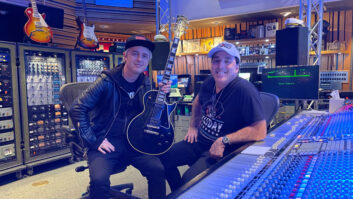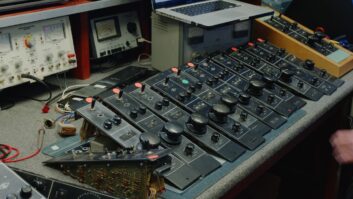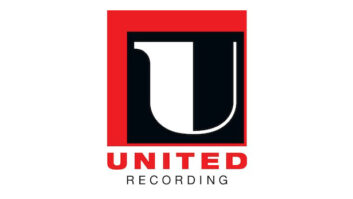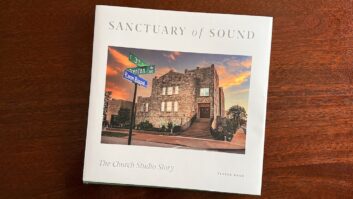Why does one great studio survive when other great studios do not? In most businesses, there’s a constant ebb and flow of swimmers and sinkers. It’s fairly clear now that the sky has not fallen on the music business. Label greed and technological changes may have caused a tsunami in the bathtub, but our little pro audio crew remains afloat on a fleet of single-mast sailboats.
Kissing Cousins console tape on the Neve 8078

The good news: Music production simply shifted to millions of sonically capable personal studios. The bad news: The seismic shift left many of the thousands of sonically notable, full-service, big studios unplugged and empty.
I first visited NRG Recording Studios in the North Hollywood neighborhood of Los Angeles seven years ago during my friend John Fields’ tracking session for a modern rock record. The label budget deluge was already drying up in 2004, but today NRG is among a handful of “name” studios still rocking in L.A. — alongside co-legends like The Village, Record Plant, Ocean Way, Capitol, Westlake, Henson (formerly Charlie Chaplin and A&M), East West (formerly Western Recorders and Cello) and The Pass, among others. And if you ask NRG president Jay Baumgardner, his studio’s success is due to both flukes and great planning.
The Genesis of NRG
If you’ve heard Papa Roach, Alien Ant Farm, Seether, Drowning Pool and Coal Chamber, you’ve heard multiplatinum producer Jay Baumgardner’s production work. If you’ve heard Evanescence, Hoobastank, Three Days Grace, Godsmack, Jewel and Bush, you’ve heard multiplatinum mixer Jay Baumgardner’s mixing work.
Before launching NRG at its current location in 1991, Jay ran several home and garage studios. Like many other notable engineer/producers of our time, he started off as a musician in a band, but when A&R guys would hear the demos they’d say, “We don’t much like the band, but your recordings are really great.” Jay got so busy making hit records in his little NoHo home studio that neighbors complained, ultimately signing a petition to evict him.
He took the opportunity to move up in the world by renting a building that already housed a studio, which he now owns. The studio had previously hosted lots of country recording sessions and jingles; at this point in the early ‘90s, it looked very dated and sounded too dead. So Jay and studio tech Wade Norton went about tearing everything out to make all the surfaces reflective, ultimately to “build the world’s greatest rock ’n’ roll studio.” It was just the beginning of 20 years of renovation and expansion into three top-flight, full-service Neve and SSLequipped studios.
Kissing Cousins sitting pretty with vintage Neumann U67 and U47 mics as dual overheads

For this third PAR Facility Review, Jay, NRG publicist Mackenzie Ramlow and studio manager Annette Scott invited me to track for two days on the custom Neve 8078 in NRG Studio B and mix for a day on the SSL 9072J in Studio C. Studio A is currently on long-term rental by a famous L.A. band — one of the increasingly rare ones with a label and a budget.
All I needed for my session was a good band and a good song.
Kissing Cousins
I started looking around for an independent L.A. band that might like to record at one of the best studios in the world. A friend of mine who is particularly in touch with the local music scene — Megan Pochebit of Off Central PR — recommended I check out a really cool, all-girl indie band. One look (and listen) to their video for “You Bring Me Down,” and I knew I had found what I needed: Kissing Cousins. Every bit of their riff-driven, badgirl, dirge rock would be enhanced by the sound for which NRG is known.
Kissing Cousins is led by singer, songwriter and guitarist Heather B. Heywood; with keyboards, vocals, and percussion from Alexis Martin Woodall; guitars and main backing vocals from Amanda Paganini; drums and vocals from Beth Zeigler; and additional writing and instruments from Benjamin Z. Heywood. A few weeks prior to the session, Heather e-mailed a rough demo of a new song called, “The Well,” which we decided to use.
NRG Studio B
The first thing Heather, Ben and I did when we got to the studio was sit together behind Studio B’s 64-channel, wraparound Neve 8078 to feel important and stay warm while we refined the song structure and arrangement, so that we could come up with a game plan for tracking. I always like to capture as many musicians playing together live without a click track as possible, and — in Studio B’s giant tracking room with Mytek Private Q headphone mixers — why not?
Alex, Heather and Benjamin work out the song arrangement

Ben and I set up the drum kit in the spot suggested by house assistant Marco Ruiz (toward the back wall under a portion of the 25-foot tall ceiling), and Heather set up her 1963 Fender Bandmaster about 20 feet away, facing the drums, so that the three of us could practice and tweak the drum arrangement. There are times when using click makes musical and logistical sense, but not for this little number. Once all the mics were set up, I recorded all the rehearsals. Our consistent, natural-feeling, keeper drum and guitar pass arrived after three official takes.
The more I record, the more I like to try new things. Usually, I spend a lot of time tweaking the tuning of the drums — not this time. We just went with the tuning Ben had already dialed in, which was working great for the arrangement. Chris Dauray from sE Microphones let me borrow a pair of sE4400a condensers (an intentionally unabashed nod to the classic AKG C 414) and the unique RN17 condensers (co-designed by Rupert Neve and Siwei Zou), which feature the world’s smallest diaphragm condenser capsule (17mm, and cardioid, in this case) coupled to a very large custom Neve output transformer.
The idea is to capture extreme sonic detail with the super-accurate, super-fast small diaphragm and compensate for inherent, small-capsule, low-frequency rolloff with a fat transformer. “Why not kick and snare,” I thought, and then stuck a sE4400a and RN-17 right next to each other on both kick and snare.
For overheads, I couldn’t decide between vintage Neumann U47 and U67 pairs, so I put up both, right next to each other, and printed both. As an afterthought while we were recording, Marco placed an AKG D 112 on the floor tom for me. It sounded fantastic, but was ultimately not used in the mix because the arrangement did not call for more floor tom than what came through the overheads. I lined up a Yamaha Subkick the same distance as the other mics from the beater.
NRG Studio B’s gorgeous, wraparound, custom Neve 8078

For room pickup, intern Brian and official NRG runner Joe put up a pair of Coles ribbon mics by the control-room glass, opposite the drum kit. It may seem a subtle visual luxury, but the floor-to-ceiling control-room glass in B made the control room and live room feel significantly more connected — important in such a big studio.
Doing my best to provide some intern hazing, I instructed Joe and Brian to place a pair of Crown PZMs as high as they could up in the 25-foot ceiling area using what they called “the ladder of death.” (I have the same ladder; it’s not that bad.) The PZMs ended up becoming my main room sound for the drums and later for the piano recording as well. I placed three ribbon mics on the guitar amp — a beyerdynamic M 160, Royer R-121 and sE Voodoo VR1 — as close as possible to one another in order to combine them into one sound. As great assistants will do, Marco already had my levels going for me when I walked into the control room to check out the sounds.
The Unique Neve 8078
Acquired by Jay from Allen Sides and Gary Belz, NRG Studio B’s Neve is a one-of-a-kind hybrid Neve 8078 with 24 1089 (same as 1073 except for EQ points) modules in the left wing and 40 1091 (essentially a 1081) modules in the main section: the most expensive Neve at the time of its construction in the mid-1970s.
According to NRG chief engineer and studio tech Wade Norton (who installed the console and has been with NRG since the beginning), “The console in Studio B was actually custom-built for a studio in Austria with the primary purpose of doing large-scale live music broadcasts. We modified the separate monitor section to include Neve 1089 modules so that it could be used for tracking as well. The desk doesn’t really have a model number since it was a one-off, but the main input modules are modeled after the 1081 module. They are actually labeled ‘1091.’ It’s similar to what an old 8078 would be like; it just looks way different. The most difficult part of installing the console was that most of it was labeled in German, including the user manual, so we really just had to figure it out.”
Despite its basis in familiar Neve parts, Baumgardner points out one aspect that makes the sound of the console unique: “The console’s main section and custom 31091 modules actually run on 30-volt rails, higher than the standard Neve 24 volts.”
Alex Oana EQ’ing on the SSL 9072J in NRG Studio C

Getting Sounds and Tracking
There’s something about the Neve 1073 that always sounds “right.” With all the drum mics and guitar mics coming into the console, I quickly assessed my initial setup. I was totally shocked to hear a superpunchy kick drum sound with high-end definition and no harshness made up of equal parts sE4400a and RN17 that needed no additional treatment.
The RN17 was shocking on snare: the crack, quickness and smoothness of the high frequencies was unlike anything I’d heard before, while the body of the snare was natural but not boring in the least (as some highend, small-diaphragm condensers tend to be). The sE4400a added more body, a bit of a 1 to 3 kHz honk and a much more veiled top.
Pushing up the faders on NRG’s U47 and U67 pairs (via 1089s) was the definition of bliss: rich midrange detail, creamy thickness, smooth top with no ouch and warm low mids … ahh! The U67s went through Neve 2264A comps, the Coles just tapped vintage black-faced 1176s (revision unknown), and I increased the Crown PZMs’ detail and reach via Slate Pro Audio Dragon dynamic processors at 2:1 with blend at 50 percent and “Sheen” engaged; the only EQ used was during drum tracking.
As I turned my attention to the room’s microphones, I was about to experience firsthand what makes the rooms at NRG legendary. When you push up the faders on your room mics you want to say, “Wow!” The thing about the NRG room sound is not only do you get “wow,” you get room sounds with the perfect amount of pre-delay, decay time and spectral content to work in rock tracks. My Crown PZMs in the overhead ceiling cove made the kit and the guitar amp sound open and airy, while the Coles pair in the back added room size and a dark thickness. Listen to audioclip #1
I recently became the vice president of creative operations for Slate Pro Audio and Slate Digital and, as luck would have it, my new boss, Steven Slate, showed up to see how I was doing with my drum sounds. To call him an authority on drum sounds would be a severe understatement. When Steven walked into the control room, his one comment was, “Sounds great … I like what you have going on here, but something’s not right with the snare. It’s not cracking and sounds a bit boxy in the low mids.” He soloed tracks, then simply shut off the 4400a snare mic and turned up the RN-17. Later, I texted Steven, saying, “You saved my snare sound!” In the mix, I ended up blending in some 4400a for thickness in the quieter song sections, but went 100 percent RN17 for the hard-hitting sections. Listen to audioclip #2
Assistant Marco Ruiz and engineer Alex Oana at the SSL 9000J in NRG Studio C

For our first overdubs on the beautiful and bright Yamaha C7 piano, I thought I’d try extending my honeymoon with the RN17 pair. Between Marco’s mic placement and these sE mics themselves, the piano sound was well balanced from top to bottom, with the top end being particularly realistic when referenced against the top-end character inside this C7; the Neumann KM84 need no longer apply. The same Crown PZM room mics I used for drums worked as room ambience for the piano, giving it a more natural “reach.” Listen to audioclip #3
Heather’s electric guitar tracks with those three ribbons fell naturally into place just as I expected, but I ultimately chose to move the amp to one of the lockers for isolation. In the mix, I rolled off highs and added mids with the SSL J EQs. For acoustic guitar, which was a forcefully plucked alternating low octave part tuned down to C#, I wanted to get both the rattle-y rasp of strings without harshness and the warm wood of the guitar: a perfect job for vintage, small-diaphragm tube condensers. The combination of hard-panned Neumann KM54 and Schoeps 221B as close mics, a center-panned Sennheiser MD441 supercardioid dynamic as a near-contact mic on the body behind the bridge and an RN17 pair in the room made for a complex, wide sound that required no doubling for depth. The RN17 pair was compressed with dual Slate Pro Audio Dragons, and all five mics were fed through two mono aux sends to the 1176 pair returning on their own faders for blend and EQ. Listen to audioclip #4
With beautifully maintained vintage tube mics and a fleet of the 1073ish 1089s at our disposal, vocal sounds were a no-brainer and, of all recording we did, the band most often commented on how amazing the vocals sounded. I did experiment with two compressors I’d not used before: the original Gates Sta-Level and a Collins limiter. My best results for Heather B. Heywood’s lead vocal came when going through the Sta-Level, then the Collins, being careful not to drive either too hard.
Switching from one vintage tube compressor in the chain to two was the sonic equivalent of opening my eyes wider. It was fun to set up the U47 and U67 on NRG’s huge stands in a 15 x 15 x 15-foot triangle pattern for Beth, Amber and Alexis’ harmony and gang vocals; for comps, I used console preamps and 1176, Dragon and 1176, respectively. The final overdub was tambo through the sE Voodoo VR1 ribbon, which has extended top that remains smooth. I love where it sat in the mix with no EQ.
Kissing Cousins and their engineer at session’s end: Beth, Amanda, Alex, Heather and Alexis

Mixing in NRG Studio C
It may be called Studio C, but I just kept thinking about how I was in “Jay’s Mix Room” where he’s mixed so many killer singles I hear on the radio, like my favorite Evanescence track, “Bring Me to Life.” Hard to believe, but our layered arrangement of drums, piano, acoustic and electric guitars and vocals added up to 93 audio tracks, because I printed almost everything discretely, with the exception of the five acoustic guitar mics which printed stereo. The first six hours of my mix were spent sorting, organizing, cleaning up and doing some subtle timing tweaks. For a diminishing few, it’s an everyday process, but for me, it took some effort to efficiently spread the 93 tracks in my session out over 64 Pro Tools outputs across the 72-channel SSL 9000J.
By evening, I was turning physical knobs and quizzing my assistant Marco on Jay’s mixing tricks. Fortunately for me, Marco said, “Jay is not a secretive guy with his tricks. He likes working with his assistants to educate them.” Marco told me how Jay rolls off the very top end of electric guitars, sends kick and snare via busses to Distressors returning on their own faders, uses Slate Pro Audio Dragons on the lead vocals, Bricasti M7 Reverb on snare and toms, sends to Sound Toys Echo Boy in Pro Tools via console aux, and most importantly has the SSL console bus compressor engaged at 4:1, 30 ms attack, .3 release.
For my mix of Kissing Cousins’ “The Well,” it was all about using this giant tool called the Solid State Logic 9000J. I used the channel comps on drums, one electric guitar and all the background vocals. SSL console EQs were applied to everything, including vocals. There’s nothing like the instant gratification of reaching out and grabbing the frequencies with my fingers. I used a total of three plug-in EQs for EQ automation and the Waves CLA-76 compressor/limiter on bass DI and amp, for which Amanda actually played baritone guitar through an octave pedal.
It’s odd making the transition from ITB (in-the-box) mixing back to an automated desk; it took some restraint to avoid the temptation to automate faders in Pro Tools. Once I got into it, I was reminded about how important it is for the mixer to interact and react in real time with the music via automated console faders. It had been a while for me, and it was a ton of fun. Within a few passes I had created a bridge arrangement just by automating the faders that would have certainly involved poking around in the DAW for a lot longer.
Add to Favorites
It’s easy as a reviewer to fall into the trap of calling everything “my new favorite this” or “one of the best that” I’ve ever heard. With that admission, I have never stayed on a studio’s main speakers throughout an entire tracking session before working in NRG Studio B.
Jay tells me he and Andy Munro codesigned them on a napkin at AES years ago and that one-off became the Dynaudio C4. I turned on the nearfields for a total of maybe 45 seconds over the course of two days. The monitoring system — passive Dyns powered by Chord amps and underpinned by double Dynaudio BM14S active subs per side — sounded right from top to bottom, with nothing missing or out of proportion, invoking the least monitoring fatigue I’ve ever experienced during tracking. I re-proved to myself that the Neve 1073 is unflappable and great at everything I want to do in a rock session. sE Electronics and Rupert Neve had already captured my heart with their new-generation ribbon mics; now they’ve done it again, but in a unique way with the super hi-fi, detailed and rich RN17.
NRG Studio B has the best acoustics I’ve encountered to date for making a rock record. Close mic, and it’ll sound close, yet open. Put up a room mic, and it’ll sound big and open.
NRG Artist Development as Business Development
“We were in the right place/right time from 1991 to 2002,” Jay told me in an interview. “NRG developed right in the middle of the explosive growth of the record industry. Now everything is paid off, we own the property and there’s not a huge overhead. Now we’re developing artists ourselves with NRG Artists. We have a social-networking department.”
NRG welcomes a range of clients and, according to assistant engineer Marco Ruiz, “The second a client walks through the door we treat them with respect no matter who they are.” Independent bands approach Jay directly on Facebook; they don’t have to go through management. Jay can help determine the budget since he owns the studio.
“You get used to being spoon-fed biglabel budgets for a few years, but that’s done,” said Jay. “Things aren’t being created from the top down anymore; if you’re waiting around for a call … you just do it. Now it’s back to being creative. Artistically, art is art. The money got so big, the game got so big, the artists just got worse and worse; the labels had picked all the low-hanging fruit.”

Finally, Jay said, “It’ll take a few years for things to develop,” so I asked him, what’s evolving here? “The artist is given a chance to evolve. Things aren’t created overnight. True artists will emerge with some development, not overnight. You have to be resourceful. Independent artists are a lot of what we’re doing now, while at the same time my mix of the new Bush record went number one and I’ve got the new P.O.D. mix coming up. We are booked for the next six months.”
Why NRG?
After learning Jay’s philosophy and business model, I was proud to have brought a true indie rock band to his studio. NRG is not a fluffy/posh studio. This is a full-service, comfortably appointed, time-tested, no BS, everything-you-need-under-one-roof studio with no sonic compromises and three world-class rooms where the sounds are great, almost no matter what the engineer does. And NRG’s monitoring clearly told me when I was going wrong.
I believe I just answered the question from an engineer’s perspective about why NRG has been rocking nonstop for 20 years.
NRG Recording
nrgrecording.com
facebook.com/nrgrecordingstudios







